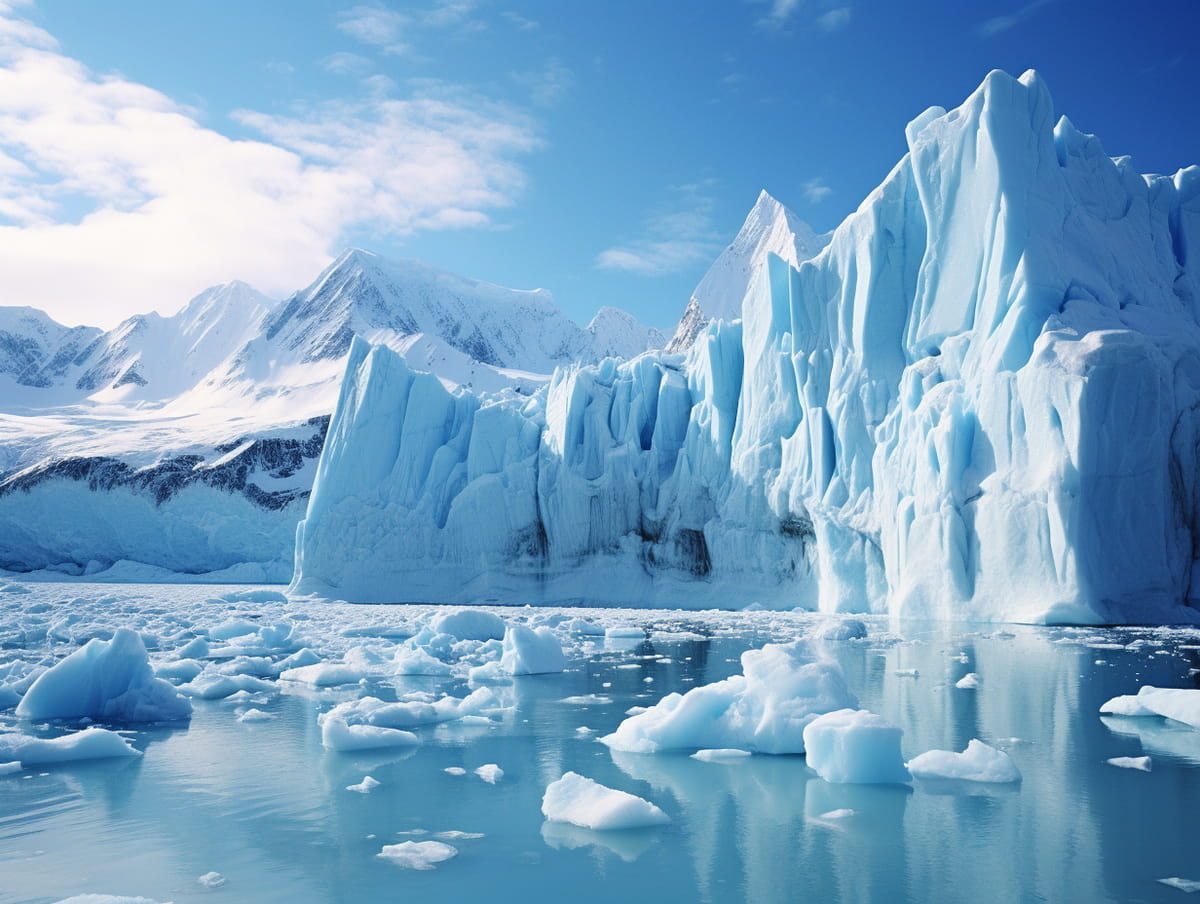Ever thought glaciers were just giant ice cubes? Think again! These titanic icy behemoths harbor tales as ancient as time, and they’re packed with more fun facts about glaciers than you can shake a snow globe at. While they might look calm and chilly on the outside, there’s a lot more to these colossal ice wonders than meets the eye.
From their thrilling creation stories to their paramount importance, these glaciers promise to surprise and entertain. So, pull up a (cold) seat, and let’s delve deep into the coolest glaciers fun facts you probably didn’t know about!
1. How Glaciers are Born: Nature’s Ice Sculptors!
Ever wondered how are glaciers formed? Imagine a thick snowfall. Now, take that imagery and repeat it year after year, compressing the snow beneath its own weight, and voila! That’s how a glacier gets its start.
This compression turns snow into dense, blue ice over time. The bluer the ice, the denser and older it is. Speaking of which, ever made a snow angel? Well, glaciers are nature’s version, only a tad heavier!
2. Perito Moreno Glacier: Argentina’s Icy Showstopper
When it comes to glaciers fun facts, Argentina’s Perito Moreno Glacier deserves its own spotlight. Nestled in the breathtaking Los Glaciares National Park, this behemoth stands out not just for its grandeur but for its baffling behavior. In an era when most glaciers are in a sad retreat, the Perito Moreno plays by its own rules, frequently advancing!
But wait, there’s more. The glacier isn’t just known for its size and movement. It’s famous for its rupture events. Every few years, as the glacier advances, it forms a dam against the Argentino Lake. Water pressure builds up until… BOOM! A spectacular rupture occurs, a phenomenon that draws tourists from all over the globe.
Did you know it also spans a whopping 250 square kilometers and is almost 30 km in length? That’s a lot of ice real estate. If glaciers had personalities, Perito Moreno would be the superstar, probably saying, “Retreat? Sorry, I don’t know her.”
3. The Slow and Steady Drift of Glaciers
Among the mesmerizing glaciers fun facts is their movement. Contrary to what some might think, glaciers aren’t static; they move! The way glaciers flow is due to the plastic deformation of their ice, caused by the immense weight of the overlying snow and ice. This movement might be likened to the way honey or molasses flows, albeit at a much slower pace.
Glaciers can advance or retreat depending on the balance between accumulation (snowfall) and ablation (melting and calving). The fascinating part? Some glaciers move mere inches a day, while others, especially in steep terrains, can move several feet!
4. An Icy Blue Riddle: Why Are Glaciers So…Blue?
Pop quiz! What’s blue, massive, and isn’t the ocean? You guessed it, glaciers! But why are glaciers blue? It’s not because they’re cold or sad. The science is simple yet fascinating. Snow is made of a myriad of tiny ice crystals, and as more snow accumulates and compresses over time, these crystals grow larger and air bubbles get squeezed out.
Without these bubbles, long-wavelength colors (like red) get absorbed, and short-wavelength colors (like blue) get scattered, giving glaciers their mesmerizing blue hue. So, the next time you’re marvelling at a Blue Glacier picture, you’ll know the chilly science behind its beauty!
5. Columbia Glacier: Canada’s Majestic Ice River
“O Canada!” indeed! Beyond the hockey, polite manners, and endless reserves of maple syrup, Canada cradles a frosty jewel – the Columbia Glacier. Nestled within British Columbia’s rugged terrain, this glacier is a spectacular expanse of shimmering ice and snow.
Let’s sprinkle in some cool (pun intended) fun facts about glaciers, shall we? Columbia Glacier is a part of the Columbia Mountains, and it plays a pivotal role in feeding the mighty Columbia River. This isn’t just any river; it’s the fourth-largest by volume in North America. That’s like being the life of the party at an ice gala!
And while it might not have the celebrity status of Exit Glacier or the paparazzi-followed Chenega Glacier, the Columbia Glacier is every bit the stunning diva in its own right. So, if you’re up for a chilly adventure and want to capture some Instagram-envy shots, this glacier is your stop. Don’t forget to bring along your thermals and perhaps a cup of steaming Canadian coffee.
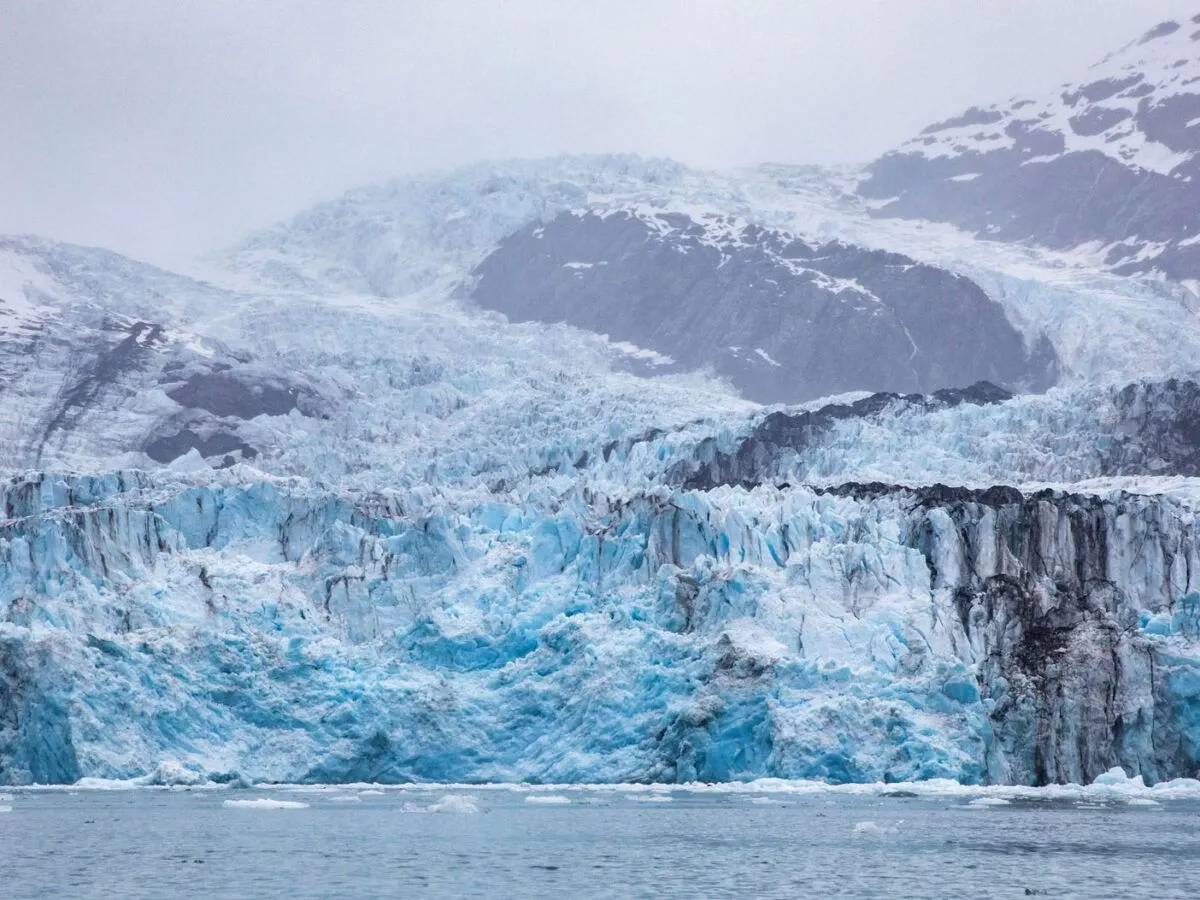
Image source: earthtrekkers.com
6. Iceland’s Glacial Paradise: More Than Meets the Eye
Iceland: where geysers erupt, volcanoes brood, and glaciers reign supreme. But did you know that about 11% of Iceland is covered in glaciers? That’s right! It’s like Mother Nature went wild with her icy paintbrush here. And while all Icelandic glaciers have their own charm, Margerie Glacier stands out for its spectacular calvings and sounds – like nature’s own orchestra!
But wait, there’s a twist. Even though it’s called Iceland, and yes, it has tons of ice, its neighboring Greenland is icier. Talk about a chilly identity crisis!
7. Antarctica: The Ice-Crowned Emperor of Earth
If glaciers had a Hollywood, it would be Antarctica. The chilly continent is not just cool, it’s frosty-levels of epic! Encompassing a staggering 90% of the world’s freshwater ice, Antarctica is the equivalent of hoarding almost every flavor at the ice cream parlor. Now that’s a sweet deal!
But let’s dig deeper, beyond the dancing penguins and icy panoramas. Meet the Upsala Glacier – one of the shining stars of Antarctica. Found snuggled on the eastern flank of the Antarctic Peninsula, Upsala has, unfortunately, been making headlines not for its beauty, but for its retreat dance moves. And the DJ causing this change? Yep, it’s our warming climate beats.
While the image of penguins in tuxedos sliding down icy slopes might be irresistible, remember, Antarctica isn’t just a winter wonderland—it’s Earth’s ultimate frozen vault, safeguarding precious freshwater.
8. Glacier Bay: A Living Laboratory
Glacier Bay in Alaska is more than just a scenic marvel; it’s a living laboratory. This vast area, once entirely covered by ice, has been experiencing rapid glacial retreat.
Today, it stands as a UNESCO World Heritage site and offers scientists a unique opportunity to study plant succession and ecosystem evolution following glacial retreat. The transformation here, from barren rock to thriving ecosystems, is both enlightening and indicative of nature’s resilience.
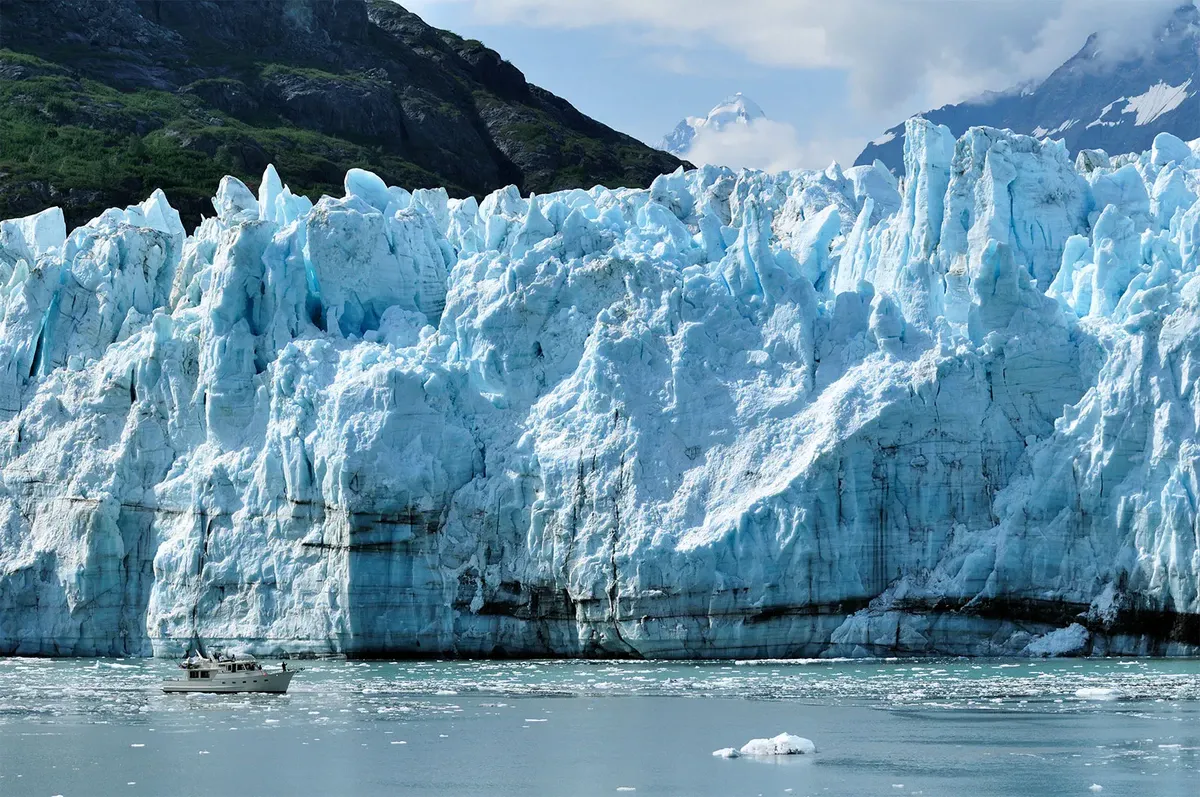
Image source: britannica.com
9. Hubbard’s Might: The Gigantic Tide-water Glacier
Welcome to Hubbard Glacier, the largest tidewater glacier in North America! Nestled in eastern Alaska and part of Yukon in Canada, Hubbard is a beast that just keeps on growing, defying the norm. It stretches over 76 miles long and plunges 1,200 feet deep in some places. That’s deeper than the Eiffel Tower is tall!
What makes it a ‘tidewater’ glacier, you ask? It flows down to the sea, meeting the shoreline. And when it calves, it sends ginormous icebergs into the ocean, making it look like Mother Nature’s own ice cube tray!
10. Franz Josef Glacier: The Rapid Retreater
Nestled in New Zealand’s South Island is the captivating Franz Josef Glacier. But here’s the catch: this glacier is one of the fastest-moving in the world, advancing at a speed of up to 70cm per day.
However, despite its speedy advance, it has been receding dramatically over the past century. Climate change and cyclic temperature variations play their part. If glaciers had life mottos, Franz Josef’s would probably be, “I like to move it, move it – but also, retreat a bit!”
11. Glacial Giants in the South: Argentina’s Upsala Glacier
Argentina isn’t just about tango and delicious steaks; it’s also home to some of the most iconic glaciers in the Southern Hemisphere. Take the Upsala Glacier, for instance. Located in Los Glaciares National Park, it’s one of South America’s largest ice masses.
However, since the 1990s, Upsala has been in rapid retreat, losing nearly 20% of its surface area. It’s a reminder that while glaciers can be vast, they’re also vulnerable. And in Upsala’s case, it’s like seeing your ice cream melt before you get to the best part!
12. Canada Glacier’s Cold Desert Secret
Here’s a chilly twist: Canada Glacier isn’t in Canada! This frosty misnomer is located in Antarctica, within the hyper-arid McMurdo Dry Valleys. Unlike its wet and dynamic glacial siblings, Canada Glacier is a cold-based glacier, meaning it’s frozen to its bed and has minimal movement.
The Dry Valleys are one of the driest places on Earth, receiving as little as 50mm of precipitation annually. So, Canada Glacier is like the introvert of the glacial world – cool, calm, and not moving much at parties.

Image source: oceanwide-expeditions.com
13. Glaciers: Earth’s Time Capsules
When we delve deep into fun facts about glaciers, it’s astonishing to realize how ancient these masses of ice are. Glaciers are akin to Earth’s historical records, with some of them containing ice that dates back over a million years!
In Antarctica, for instance, deep ice core samples extracted from its glaciers have provided scientists with invaluable information about the planet’s past climate and atmospheric conditions. These cores reveal layers upon layers, similar to tree rings, each telling a story about a particular period in Earth’s history. When you gaze upon a glacier, you’re not just observing a mass of ice; you’re witnessing a frozen archive of our planet’s climatic past.
14. Glaciers: The Heavyweights that Shape the Earth
Glaciers don’t just sit idly on Earth’s surface; they interact with it in profound ways. Due to their colossal weight, glaciers can compress the Earth’s crust. In places with significant glacial coverage, this pressure can be intense.
For instance, the massive ice sheets in Greenland exert so much weight on the land beneath that when these glaciers melt or diminish in size, the previously compressed land starts to rise, a phenomenon known as “isostatic rebound.”
It’s a slow process but a clear testament to the glaciers’ immense weight and influence. Imagine pressing your hand on a sponge and then releasing – the sponge expands back to its original shape. That’s similar to how Earth’s crust reacts once the weight of the glacier diminishes.
15. Icebergs: Glaciers’ Offsprings Setting Sail
When glaciers meet the sea, chunks of ice break off in a process called ‘calving’, creating icebergs. These floating pieces can range from small chunks to massive, multi-story behemoths.
Once birthed, icebergs embark on oceanic journeys, carried by currents and wind. While the sight of an iceberg might evoke feelings of awe, what we see is just the tip, with nearly 90% of its mass hidden underwater.
16. Glacial Rivers: The Meltwater Maestros
Glaciers, as they melt, give birth to rivers. These glacial rivers, with their unique silty appearance, often referred to as “glacial milk,” carry with them finely ground rock particles from the glacier’s path. This is why many glacial rivers have a characteristic light gray or bluish hue.
Apart from their scenic beauty, they play a vital role in the ecosystems they flow through, providing habitats for a myriad of species.
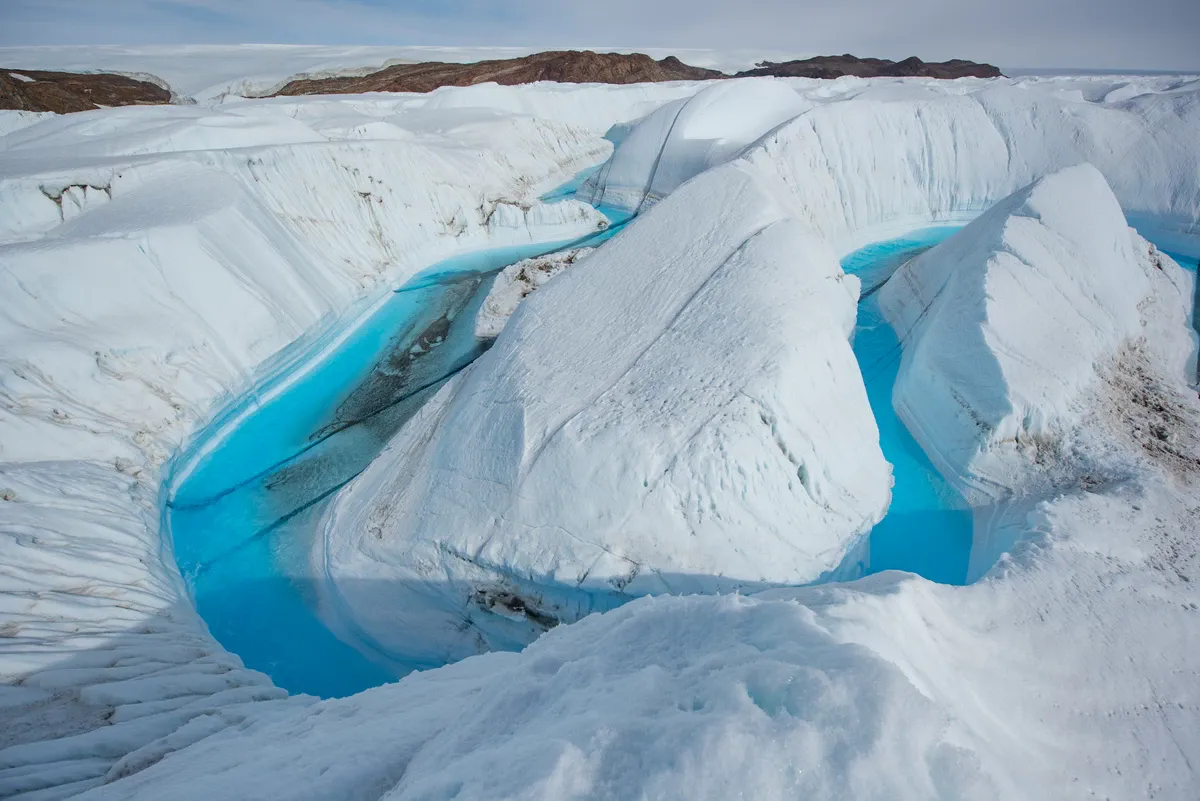
Image source: Lewis Pugh / Twitter
17. Glacial Grooves: Nature’s Etchings
As glaciers move, they don’t just flow silently. They pick up rocks and debris, effectively turning their bases into gigantic sandpapers that etch deep grooves into the bedrock below.
These ‘glacial striations’ can be seen on exposed rock surfaces long after the glacier has receded. These grooves tell stories of a glacier’s direction of movement and offer clues about its size and the debris it once carried.
18. Glacial Flour: The Secret Ingredient to Azure Lakes
Ever wondered why some lakes in glacier regions have a mesmerizing turquoise hue? Enter “glacial flour.”
As glaciers grind the bedrock beneath, they produce this fine sediment. When meltwater from glaciers flows into lakes, it brings along this “flour.” The sediment particles reflect sunlight in such a way that the water often appears bright blue or turquoise.
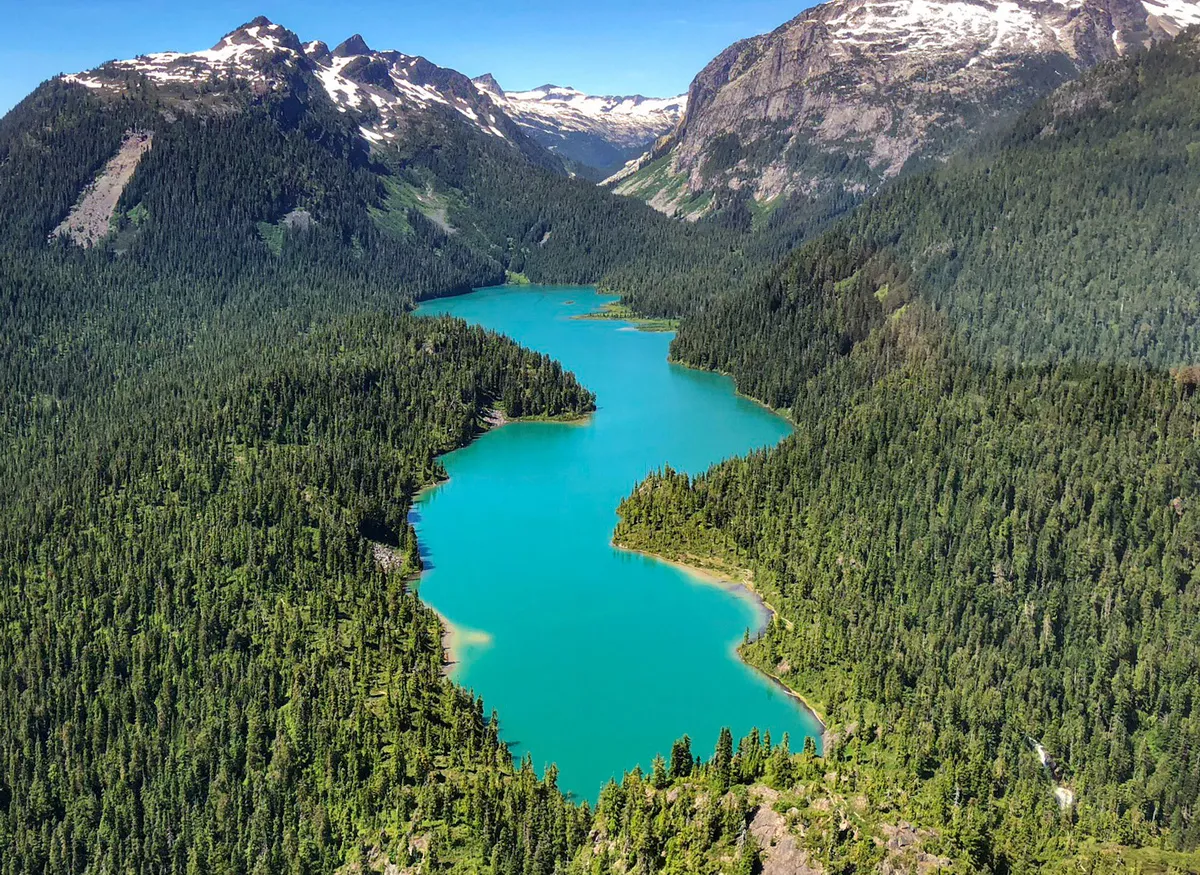
Image source: seatoskyair.ca
19. Blue Glacier: The Colorful Giant
Speaking of color, let’s turn our attention to the Blue Glacier. Glaciers often appear blue because ice absorbs all colors of the spectrum except blue, which it reflects.
Blue Glacier, located in the Olympic Mountains of Washington State, stands as a brilliant exemplar of this. With its sprawling icefalls and crevasses, this glacier offers a visual treat and acts as a living classroom for glacial studies.
20. Glaciers: Earth’s White Reflectors
Glaciers and ice sheets play a vital role in reflecting solar radiation back into space. This reflective ability is termed “albedo.” White surfaces, like those of glaciers, have a high albedo, meaning they reflect a significant amount of sunlight. This natural reflection helps regulate Earth’s temperature.
However, as glaciers recede and the Earth’s surface becomes less white and more exposed, it leads to increased absorption of sunlight, further contributing to global warming.

Image source: nsidc.org
21. The Sounds of Melting Glaciers
Believe it or not, glaciers are chatty! If you were to place your ear close to a melting glacier (mind the cold!), you’d hear snaps, crackles, and pops. This is because when glaciers melt, air bubbles that have been trapped in the ice for centuries are released.
These sounds are not only a testament to the age and history of the glacier but also a grim reminder of the rapid rate at which many of them are melting today.
22. Exit Glacier: A Walkable Wonder
Exit Glacier, located in Alaska’s Kenai Fjords National Park, is one of the most accessible glaciers in the world. Visitors can literally walk up to and alongside this moving river of ice, witnessing the dynamic nature of glaciers firsthand.
Educational markers along the trail indicate the glacier’s rapid retreat over the years, making it not only a visual marvel but also an environmental classroom.
23. Glacier Mice: The Rolling Moss Balls
In the realm of weird glacier phenomena, glacier mice deserve a shoutout. These aren’t rodents but rather moss balls that form on some glaciers.
Rather intriguingly, these moss balls move – almost as if they have a life of their own! They roll around, ensuring each side gets equal sunlight, thereby enabling them to thrive in such icy environments.
24. Mendenhall Ice Caves: A Dreamlike Voyage
Tucked inside Mendenhall Glacier in Alaska is a surreal world of blue – the Mendenhall Ice Caves.
Inside, you’re enveloped in a dreamlike realm where everything is tinted in shades of blue and azure, thanks to the unique play of light through the ice. But here’s a heartache: these ice caves are retreating. As melting intensifies, sections of the cave could collapse or become inaccessible.
25. Glaciers & Sea Level: The Melty Relationship
Alright, time for some relationship talk. Glaciers and sea level have this complicated relationship. When glaciers (especially those not on polar land) melt, they contribute directly to rising sea levels.
It’s like glaciers are constantly pouring their meltwater into the Earth’s already full bathtub. And with the current rate of glacial melting, coastal cities might just have to invest in some very tall rain boots.
26. The Hidden Worlds Beneath: Subglacial Lakes
Imagine having an entire lake, sealed off from the world, lying beneath thick layers of ice. Subglacial lakes are essentially that – vast bodies of water trapped under glaciers.
Antarctica alone boasts over 400 of these hidden lakes. It’s like Mother Nature’s secret stash of bottled water, just waiting to be discovered.
27. The Glacier’s Nose: Terminus Talk
The end of a glacier? It’s called a “terminus”. This is where our chilly friend loses its ice either by melting, calving, or sublimation. But unlike our noses, a glacier’s terminus can change position.
Depending on whether the glacier is advancing or retreating, the terminus can move further down valley or up valley, respectively. Think of it as the glacier’s way of playing a very slow game of peekaboo.
28. Sawyer Glacier: A Tidewater Delight
Tucked into Tracy Arm Fjord in Alaska, the Sawyer Glacier is a tidewater glacier that’s as majestic as they come. These types of glaciers flow directly into the ocean, producing dramatic calvings where chunks of ice break off and become icebergs.
Tourists flock to witness this awe-inspiring process, and it’s said that the splash created can rival the theatrics of any high-dive competition!
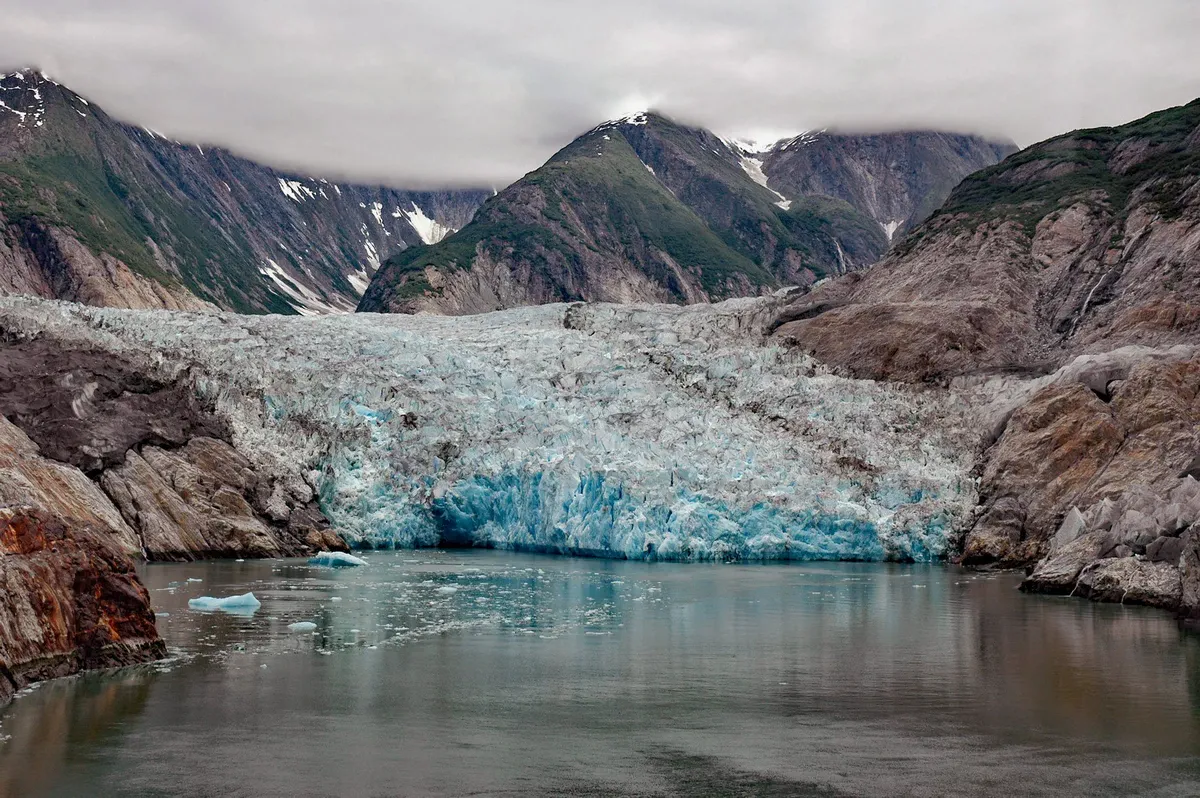
Image source: coastview.org
29. Glacial Earthquakes: When Giants Tremble
Though glaciers might seem stationary, they’re often on the move and can cause seismic activity. These “glacial earthquakes” occur when massive pieces of ice break off (or calve) from a glacier and then crash into the sea.
The scale of these quakes can sometimes be equivalent to magnitude 5 earthquakes! It’s nature’s version of a mic drop, but with a lot more ice and drama.
30. Say Cheese at Margerie Glacier!
Residing in the spectacular Glacier Bay in Alaska, Margerie Glacier is a celebrity in its own right. Why, you ask? It’s an actively calving glacier, giving tourists a good chance of witnessing its icy theatrics.
At a towering 250 feet above sea level and another 100 feet beneath, this glacier is the perfect backdrop for your next profile picture. Just remember to wear something warm!
31. Glacier Detectives: Telltale Moraines
Ever fancied playing detective with a glacier? Enter moraines, your trusty clues. These are essentially dirt and rock accumulations that glaciers pick up as they slide downhill. Think of them as the breadcrumbs that glaciers leave behind in their icy journey.
There are different types of moraines: lateral moraines (found on the sides of glaciers), terminal moraines (at the glacier’s snout), and medial moraines (formed when two glaciers merge). Moraines are crucial for scientists, as they tell tales of past glacial extents and movements. For instance, terminal moraines show the furthest point a glacier advanced before retreating.
So, the next time you gaze at a moraine, know you’re looking at a time-stamped signature of a glacier’s history.
32. Deep Dive: Glacial Crevasses
Not all cracks are created equal, especially when you’re talking glaciers. Crevasses, deep splits or fractures in the ice, often span many meters in width and depth. They form due to the differential movement of the glacier’s ice. When the ice moves and stretches beyond its ability to maintain its structure, it cracks, forming these treacherous crevasses.
But here’s where it gets intriguing: the patterns of these crevasses can tell glaciologists about the underlying terrain and how the glacier moves over it. However, for mountaineers and explorers, these crevasses pose significant challenges. They can be concealed by snow bridges—making them perilous traps for the unaware. Despite their danger, there’s a haunting beauty in their intricate, jagged patterns—a testament to the dynamic, ever-changing nature of glaciers.
33. Glaciers: The Earth’s Largest Freshwater Reservoir
While oceans occupy a whopping 71% of the Earth’s surface, they’re saline. When it comes to freshwater, glaciers and polar ice hold about 69% of the world’s reserves. This makes them critical to global water cycles.
Despite their frozen state, they act as freshwater reservoirs that gradually release water over time, supporting river systems and ecosystems around the world. Talk about the ultimate water bank!
34. Oxygen Isotopes: The Climate Time Machine
One of the more science-y fun facts about glaciers is how they act as Earth’s diary, especially when it comes to oxygen isotopes.
Layers of ice in glaciers have varying amounts of oxygen isotopes depending on the climate when they were formed. By studying these, scientists can paint a picture of our planet’s past climates, diving deep into history, sometimes spanning hundreds of thousands of years. It’s like Earth’s own version of a time capsule!
35. Glacier Archaeology: History Unfrozen
As glaciers recede, they sometimes reveal ancient artifacts and remains that have been preserved in the ice for thousands of years. From ancient weapons and tools to remarkably well-preserved human remains, these icy time capsules offer a unique window into the past.
Every melting glacier can be like a page turning in a history book, providing archaeologists and historians with invaluable insights into ancient cultures and civilizations.
FAQ
What are 10 interesting facts about glaciers?
- Ancient Ice: Some glaciers have ice that’s over 100,000 years old! The layers of ice in a glacier can tell scientists about past climates, much like the rings of a tree can tell about past growing conditions.
- Earth’s Freshwater: Glaciers store about 69% of the world’s freshwater. If all the land ice present in glaciers and ice caps were to melt, it would raise sea levels by about 70 meters (230 feet).
- Moving Rivers of Ice: Though they might seem static, glaciers are actually moving bodies of ice. They flow like slow rivers, and this movement can be due to internal deformation, sliding at the base, or a combination of both.
- Glacial Landforms: The movement of glaciers shapes the landscape. Features such as moraines, drumlins, and glacial valleys (U-shaped valleys) are all formed by glacial activity.
- Icebergs: When glaciers that flow to the sea reach the coastline, large chunks can break off, or ‘calve’, forming icebergs. Only about 10% of an iceberg is visible above the water’s surface, the rest is submerged.
- Glacial Flour: As glaciers move, they grind down the rock beneath them, creating a fine powder known as “rock flour” or “glacial flour.” When this is suspended in meltwater, it can give rivers and lakes a distinct milky-blue tint.
- Surging Glaciers: While most glaciers move at a very slow pace, some can experience a phenomenon known as a surge, where they move forward rapidly in a very short period of time.
- Cryokonite Holes: These are small cylindrical holes that form on the surface of a glacier. They are created when dark debris on the ice absorbs sunlight, melts the ice beneath, and sinks, creating a hole.
- Moulins: These are vertical shafts within a glacier, formed when meltwater on the glacier’s surface drains down through the ice. They play a major role in transporting water from the surface to the base of the glacier.
- Retreat and Advance: Glaciers are often used as indicators of climate change. When a glacier retreats, it is often (but not always) due to warming temperatures. Conversely, when it advances, it’s generally because of cooler conditions. However, local factors such as snowfall and its rate of melting can also affect a glacier’s movement.
What is unique about glaciers?
Glaciers are essentially rivers of ice, but unlike water rivers, they can carve out valleys and shape landscapes in very unique ways due to their immense weight and slow movement. Their ability to preserve information about past climates, including trapped air bubbles in the ice, makes them invaluable for scientific research.
What are some interesting facts about glacier melting?
- Glacier melt contributes significantly to sea-level rise.
- The rate of glacier melting has accelerated in recent decades, likely due to global climate change.
- Glacier retreat can expose long-buried ecosystems and even ancient artifacts.
- Meltwater from glaciers can lead to the formation of glacial lakes, which can cause catastrophic outburst floods known as glacial lake outburst floods (GLOFs).
How many glaciers are on Earth?
There are over 200,000 individual glaciers worldwide.
How old is the oldest glacier?
Some of the ice in the Antarctic Ice Sheet is estimated to be around 1 million years old, making parts of it the oldest known glacier ice on Earth.
What is the largest glacier in the world?
The Lambert-Fisher Glacier in Antarctica is considered the world’s largest glacier. It’s about 400 kilometers (250 miles) long and up to 100 kilometers (60 miles) wide.
What is the deadliest glacier?
It’s hard to label any one glacier as the “deadliest,” but glaciers in high-altitude areas like the Himalayas can be particularly dangerous due to avalanches, crevasses, and sudden glacial lake outburst floods.
Why are glaciers blue?
Glacier ice is compacted and dense, which causes it to absorb all colors of the spectrum except blue. The blue is then reflected back to our eyes. The denser the ice, the bluer it appears.
What are the 3 longest glaciers in the world?
- Lambert-Fisher Glacier, Antarctica, is the longest, as mentioned above.
- Siachen Glacier in the Himalayas is one of the largest glaciers outside the polar regions.
- Biafo Glacier in Pakistan’s Karakoram Mountains is another of the world’s longest glaciers outside the polar regions.
It’s worth noting that the order and inclusion can vary based on measurements, and there are other contenders for the longest glaciers, especially in the polar regions.
How fast do glaciers move?
The speed of a glacier’s movement can vary widely. Some glaciers move just a few centimeters a day, while others can move several meters in a single day. The speed is influenced by factors like the slope of the terrain, the thickness of the ice, and the temperature at the glacier’s base.


